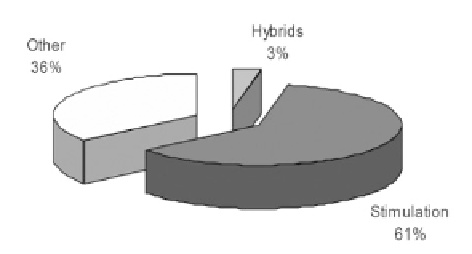Agriculture Reference
In-Depth Information
72 h after sowing, the difference in the number of germinated seeds was almost not
observed or equals the control.
It is found that calibrated seed stimulation is affected signifi cantly by the increase
on its germination energy on both the biological forms of sugar beet. Thus, if the
germination energy of calibrated seeds of diploid and triploid hybrids before stimu-
lation was 90 percent, it increased by 4 percent (LSD
05
stimulating factor = 1.2%)
after stimulation and made 94 percent. Seed germination signifi cantly increased after
stimulation of both biological forms of sugar beet. No signifi cant differences in germi-
nation energy and germination seed was found out depending on seed parties studied
as diploid and triploid hybrids. After stimulated calibrated seed pelleting, the germina-
tion energy and germination of both the biological forms of beets were equal to those
before the pelleting, but signifi cantly higher compared with control. Thus, the germi-
nation energy and germination of pelleted seeds of diploid hybrids were identical and
made 95 percent, which is 5 and 3 percent high than in the control, respectively, and in
triploid hybrids these indexes of pelleted seeds were equal and made 94 percent, which
is 4 and 2 percent more than in the control.
It was found out while determining the factors infl uencing on the laboratory germi-
nation of seeds that the “stimulation of seed” factor was the most signifi cant and made
61 percent (Figure 18.6).
FIGURE 18.6
The share of factors influencing on seed germination (average of 12 parties of
seeds, 2012).
The infl uence of biological forms of beet was insignifi cant and made only 3 per-
cent, and the infl uence of other factors (presence of fi lled but dead fruit and others)
was signifi cant and made 36 percent.
18.4 CONCLUSIONS
-
The directed regulation of flowering processes and flower formation of seed
plants of mating components has a positive effect on the processes of growth
and development and, especially, on the synchronization of flowering and the
degree of tying seed and consequently its yield and quality. The yield of seed
and its quality are significantly increased compared with the control (without
minting) as a CMS component of the O-type.
















Search WWH ::

Custom Search